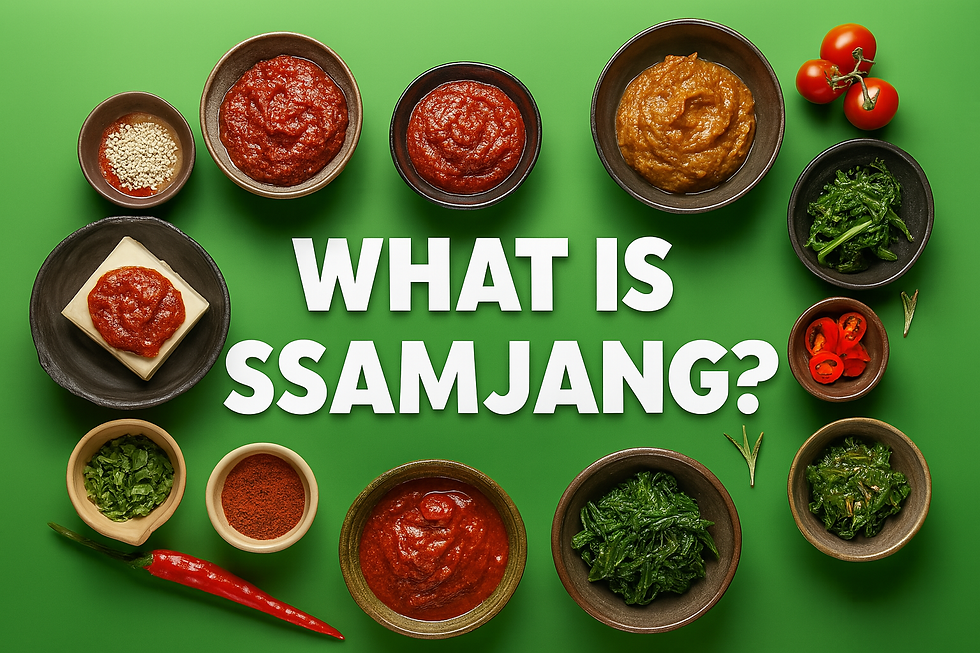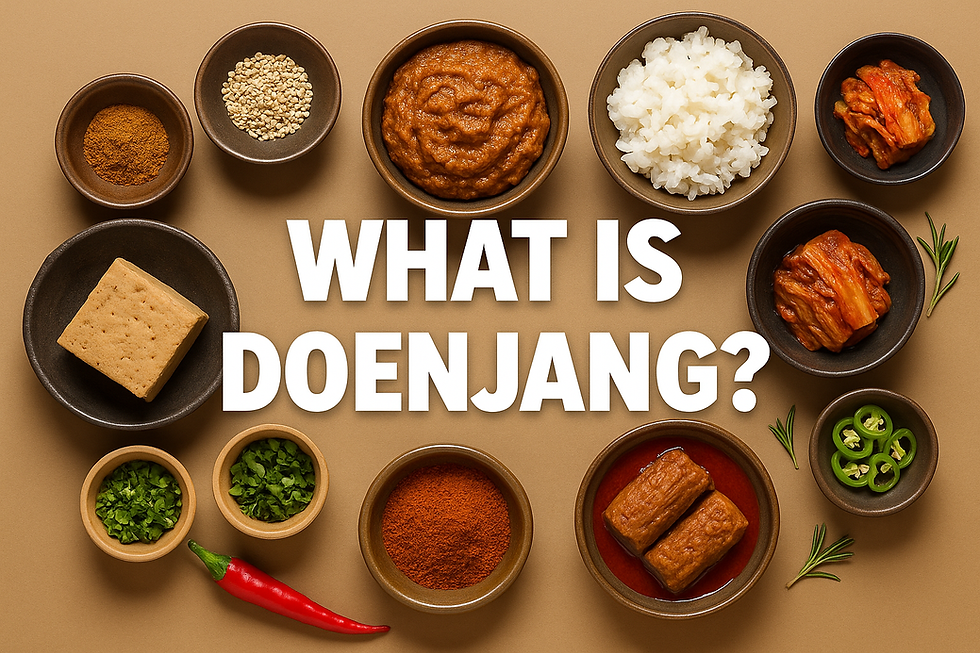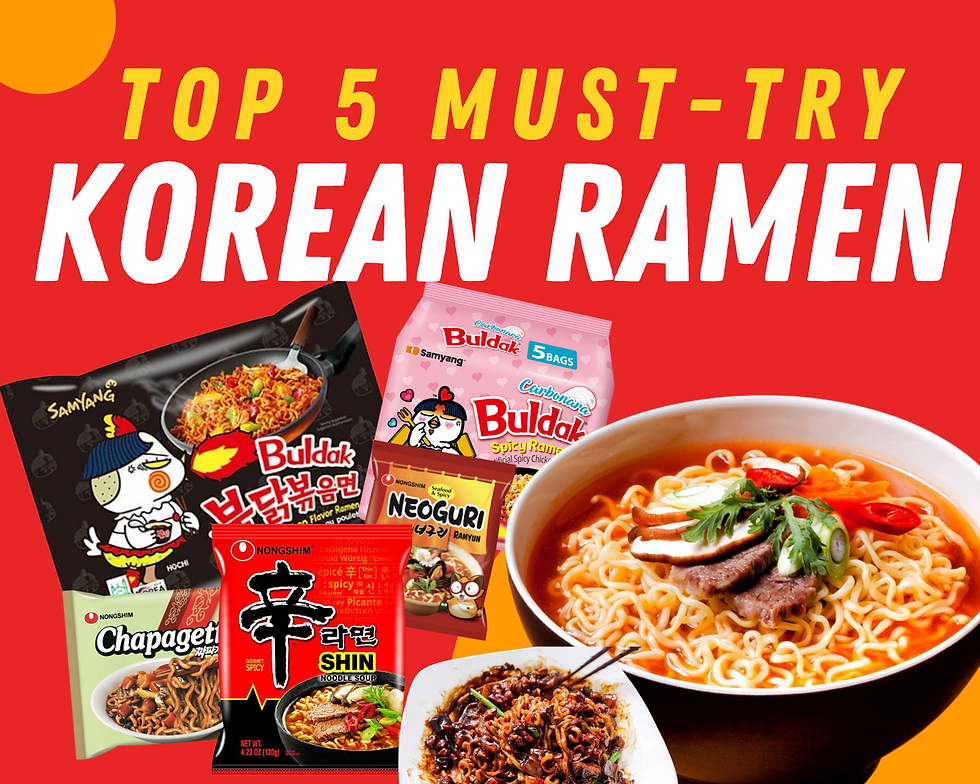What is Ssamjang? The Ultimate Sauce That Pulls It All Together
- MyFreshDash

- 4 days ago
- 4 min read
Updated: 3 days ago

When it comes to Korean BBQ, the meat gets all the hype. Samgyeopsal. Galbi. Bulgogi. The grill is hot, the smell is intoxicating, and the sizzle is its own kind of music.
But anyone who's had a proper Korean wrap knows—something magical happens when that final spoonful of ssamjang hits the wrap.
It’s not flashy. It’s not trying to steal the spotlight. But without it, the bite just doesn’t land the same.
Ssamjang is the glue. The punch. The secret handshake between meat and leaf. Thick, nutty, salty, slightly spicy, and deeply satisfying—it’s the flavor that pulls every part of your BBQ plate into one harmonious bite. Like someone turned umami into a condiment and gave it attitude.

What’s wild is that most people outside of Korea have no idea it exists.
But in Korean households? It’s not optional. It’s assumed. No ssamjang at the table = incomplete meal.
It was never invented by a chef in a lab. It was stirred together in home kitchens by moms and grandmas who were tired of choosing between doenjang and gochujang and just said: “Why not both?”
They added garlic, sesame oil, green onions—maybe a pinch of sugar. They didn’t call it fusion. They just called it dinner.
That’s how ssamjang was born: not out of marketing, but out of pure, delicious necessity.
And while it made its name sitting next to grilled pork belly and lettuce, the truth is… ssamjang is for way more than BBQ night.
🥄 What Exactly Is In It?
There’s no one fixed recipe, but the base is always the same:
Doenjang – The earthy, salty fermented soybean paste that gives ssamjang its deep foundation.
Gochujang – The fermented red chili paste that adds warmth, sweetness, and just enough spice.
Garlic – Because of course.
Toasted sesame oil – For that smooth, nutty aroma that rounds out the edges.
Green onion – For bite and freshness.
Some families add honey. Some add crushed nuts. Some make it chunkier, some smooth. But the soul of ssamjang is that it feels homemade—like it came from someone’s fridge, not a factory.
🥬 Why It Works So Well With Korean BBQ

Let’s paint the picture:
You’ve got a leaf of romaine or perilla in your hand. You add a piece of grilled pork belly—crispy on the edges, juicy in the center. Then a slice of garlic. A strip of raw chili. Maybe a little rice. And finally—a dab of ssamjang.
The bite transforms. The meat’s richness is cut with salt and spice. The raw garlic and chili are grounded by umami and depth. The wrap becomes more than the sum of its parts.
That’s the ssamjang effect. It doesn’t compete—it connects.
It brings harmony. It adds swagger. It’s not a topping—it’s a closer.
In Korean homes, ssamjang isn’t just for BBQ night. It shows up everywhere:


🛒 Homemade or Store-Bought?
You can definitely make ssamjang from scratch, and we even carry all the ingredients for it at MyfreshDash. But if we’re being real? Most people in Korea buy it pre-made.
And honestly—it’s delicious.
The tubs you’ll find in Korean markets (and on our site) have all the right balance, plus the punch and texture you want, without having to raid five jars every time you want a bite.
Wanna Make Your Own Ssamjang?

We get it. Sometimes you want the real-deal, hand-mixed, I-made-this-myself experience—especially when it comes to something as iconic as ssamjang.
Whether you’re trying to impress at K-BBQ night or just craving that perfect bite with your rice and lettuce wrap, here’s a super easy, foolproof way to whip up homemade ssamjang that tastes like it came straight out of a Korean kitchen.
🥣 Homemade Ssamjang Recipe
What You’ll Need:
2 tbsp doenjang (fermented soybean paste)
1 tbsp gochujang (Korean chili paste)
1 tbsp sesame oil (toasted is best)
1 tbsp honey (or sugar if that’s what you have)
1 tbsp finely chopped green onion
1 tbsp minced garlic
1 tsp toasted sesame seeds
Optional (but delicious):
A little minced onion
Crushed nuts (walnuts or pine nuts)
A dash of vinegar or chopped chili for a tangy or spicy kick
How to Make It:
Grab a small bowl and mix the doenjang and gochujang first until they’re fully blended.
Add in the garlic, green onion, honey, and sesame oil. Stir until it looks glossy and thick.
Sprinkle with sesame seeds (and any extras you want).
Let it rest for 5–10 minutes so the flavors come together—or dive in right away.
So whether you mix it yourself or grab a tub from us, the goal is the same: get ssamjang on your table, fast.
💬 So Why Choose Ssamjang?
Because flavor isn’t just about taste—it’s about balance. Ssamjang does what few condiments can: it brings everything together without overpowering. It listens more than it talks. It makes bold things taste intentional.
In Korean food culture, ssamjang isn’t just a sauce—it’s a comfort. It’s what people reach for when the table is full, the grill is hot, and the wraps are flying.
It’s not about trendiness. It’s about that familiar, satisfying moment when all the flavors snap into place.
And whether you’re building your first lettuce wrap or topping off a midnight rice bowl, ssamjang’s there—quietly making it all taste better.
From Our Fridge to Yours — Get to Know Ssamjang
At MyfreshDash, we don’t just stock Korean ingredients—we live them, love them, and eat them every week. Ssamjang is part of that.
It’s not just a paste. It’s a mood. It’s a flavor.And once you taste it, you’ll wonder why you waited so long.
Trust us: your fridge needs this.

.png)




Comentários